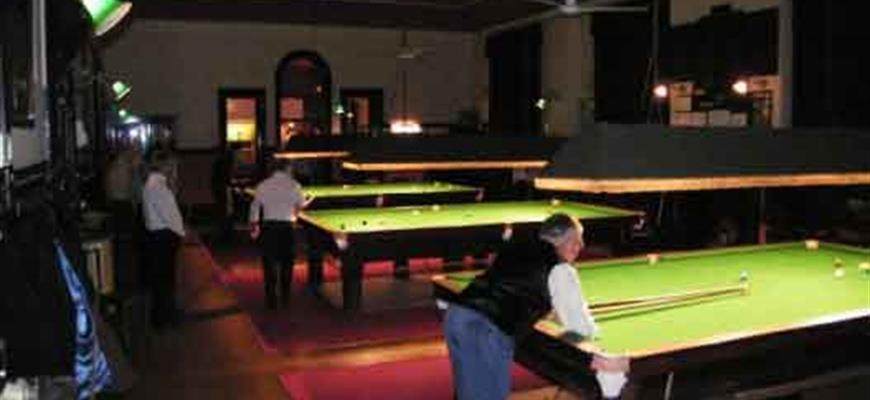The Northampton and County Club is a gentleman's club, housed in a historic building, which was formerly a town house, a pub, and the town's first infirmary.
The Northampton and County Club is a Grade II-listed building on George Row, Northampton, within the All Saints Conservation Area. It was built after
the Great Fire of Northampton in 1675, which destroyed most of the town. It forms part of a handsome row of listed buildings that also includes the Sessions House. A feature of the outside of the building is a central porch with Doric columns. Inside, there is a well-preserved, late 17th-century staircase and an early 18th-century ceiling. Under the house are medieval vaulted cellars.
A local inn
Before
the Great Fire of Northampton, a number of inns stood on the road now known as George Row. The Adam and Eve inn was located where the Club now stands, with the Bell inn next door. Buildings above ground were destroyed by the fire, but the 14th-century stone cellars survived. They could have been used as storage for beer and wine, but as they had an entrance on street level, they could also have been a basement shop or an alehouse. It is unlikely, however, that such a fine vaulted structure would have been built as an inn cellar, even if it was used as that later.
The town infirmary
In the early 18th century, following
the Great Fire of Northampton, a fine town house was built on the site. The owner, Mr William Lane, rented the town house out and it became the first town infirmary.
When Dr James Stonhouse arrived in Northampton in 1743, he saw the need for a hospital in the town. After he became friends with
Philip Doddridge, they started a campaign and a subscription list. By the end of the year, with the help of a committee of titled gentlemen, they had rented the town house on George Row for £30 a year (worth around £3500 today).
Because the infirmary and patient care was funded by donations, donors would buy ‘hospital letters’, which patients could use to pay for their admission. They also had to pay fifteen shillings ‘caution money’ to cover burial expenses in case the patient did not recover. This was refundable if the patient was cured.
On the opening day, ten patients were admitted. They were aged 13 to 40 and had a range of ailments. It is recorded that by the end of that year, six of these ten patients had been cured, one had died, two were incurable, and one had been made an outpatient.
Life in the infirmary was not easy for the patient. Rules were strict, conditions were insanitary, and the range of cures was limited. When the patient started to recover, they were expected to help with cleaning and nursing duties. On leaving the infirmary, it was obligatory to write a letter of thanks to the Governors.
The first infirmary existed for sixty years, until a new hospital was built in 1793 on Billing Road. It is now called
Northampton General Hospital.
A town house again
The old infirmary was auctioned in 1792 to Mr Charles Smith, a lace merchant. By 1830, a banker called Mr Henry Whitworth owned it. He and his family lived in part of the house and rented out the rest to businesses. When Henry Whitworth died, his widow sold the property and two adjoining houses to the Northampton Club Company in 1878.
A gentlemen’s club
In 1873, a group of Northamptonshire gentlemen set up the Northampton Club Company “for chess, billiards and news.” They wanted two billiard tables and a room large enough for refreshments, such as chops, welsh rarebits, and cheese. They found a space but the Club’s popularity meant that within five years it had outgrown its premises. The former infirmary in George Row was bought and the gentlemen moved in. The purchase included “yards, gardens, orchards, stables, coach house, granaries and offices to the rear.”
Costly alterations were needed to make the old buildings suitable for Club use. Architect William Hull prepared plans for changes to the existing buildings. This included adding a large brick extension to the rear with dining and bar facilities, a kitchen, and a magnificent three-table billiards room.
 Since then the Club has flourished and members have come from many local businesses, including many from the legal profession. Membership is now open to both men and women, and non-members can hire the beautiful premises for large functions or dinner parties.
Since then the Club has flourished and members have come from many local businesses, including many from the legal profession. Membership is now open to both men and women, and non-members can hire the beautiful premises for large functions or dinner parties.
Acknowledgements:
All text except section on the town infirmary © Enid Jarvis,
Northampton and County Club archivist
Text on the town infirmary © Sue Longworth, archive volunteer at the
Northampton General Hospital Archive
George Row infirmary ©
Northampton General Hospital Trust
Billiards room, Northampton and County Club ©
Northampton and County Club
Northampton and County Club entrance ©
Northampton and County Club
Northampton General Hospital Archive ©
Northampton General Hospital Archive